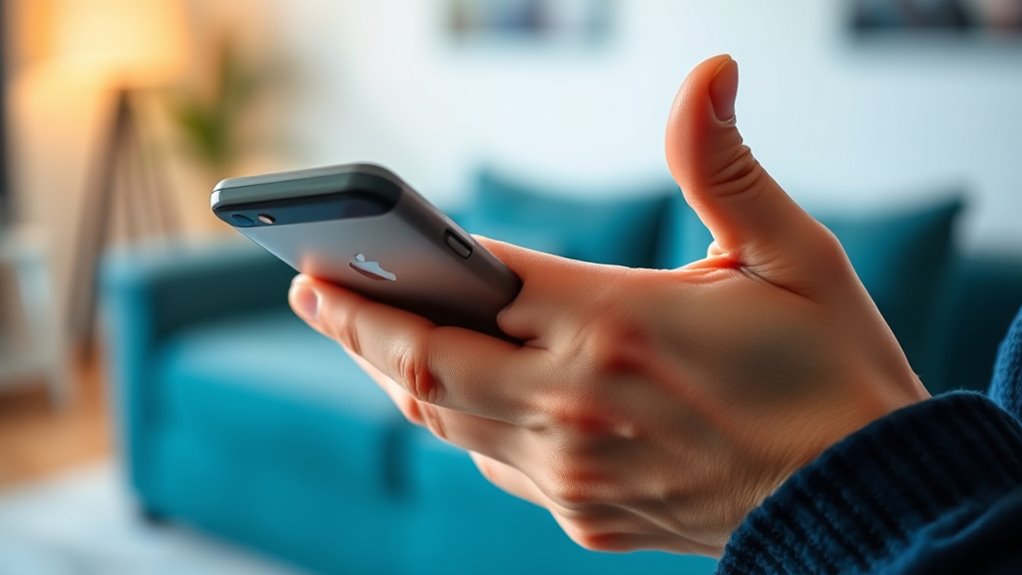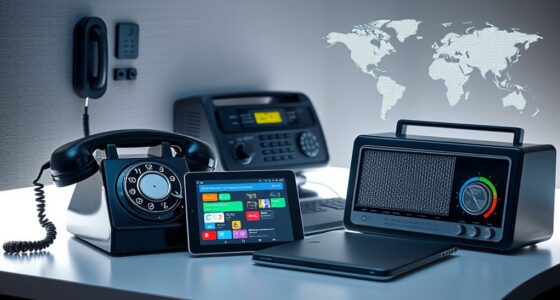DeafBlind individuals access smartphones and online services through a combination of tactile devices, Braille displays, and voice-activated assistants. These tools translate digital content into touch or sound, allowing you to navigate apps, send messages, and interact with devices independently. Many use specialized tactile feedback and customized mobile apps designed for accessibility. If you keep exploring, you’ll discover how ongoing innovations are making digital spaces even more inclusive for everyone.
Key Takeaways
- DeafBlind individuals use tactile devices and Braille displays to access digital content through touch-based interfaces.
- Voice-activated assistants enable hands-free navigation and communication, reducing reliance on visual or auditory cues.
- Accessible mobile apps incorporate haptic feedback, tactile signals, and customizable notifications for better usability.
- Tactile graphics and overlays help DeafBlind users interpret images, maps, and diagrams online.
- Community support and innovative assistive technologies foster independence and enhance engagement with smartphones and online services.
The Unique Challenges Faced by DeafBlind Users in the Digital World

DeafBlind individuals encounter significant obstacles when traversing the digital world because most technology is designed for sighted and hearing users. Sensory deprivation makes it difficult to access visual or auditory cues that others take for granted. You may find it hard to navigate screens or understand alerts without tactile or alternative feedback. Communication barriers further complicate your digital experience, as text-based interfaces rely on sight, and audio cues are useless. This limits your ability to interact seamlessly with online content, apps, or services. Without specialized tools, you might feel isolated or frustrated, unable to fully participate in digital communication. Overcoming these challenges requires innovative solutions that address both sensory deprivation and communication barriers, making digital access more inclusive for everyone. Understanding accessible technology is essential for developing tools that can bridge these gaps effectively. Incorporating multisensory feedback can also enhance usability for DeafBlind users, enabling a more intuitive and accessible interaction experience. Additionally, advancements in assistive communication devices can significantly improve independence and social connection. Moreover, ongoing research into haptic feedback systems offers promising avenues to create more effective tactile cues for users with combined sensory impairments. Furthermore, integrating tableware concepts like tactile differentiation can inspire new designs for tactile feedback systems tailored for sensory impairments.
Assistive Technologies Transforming Accessibility for DeafBlind Individuals
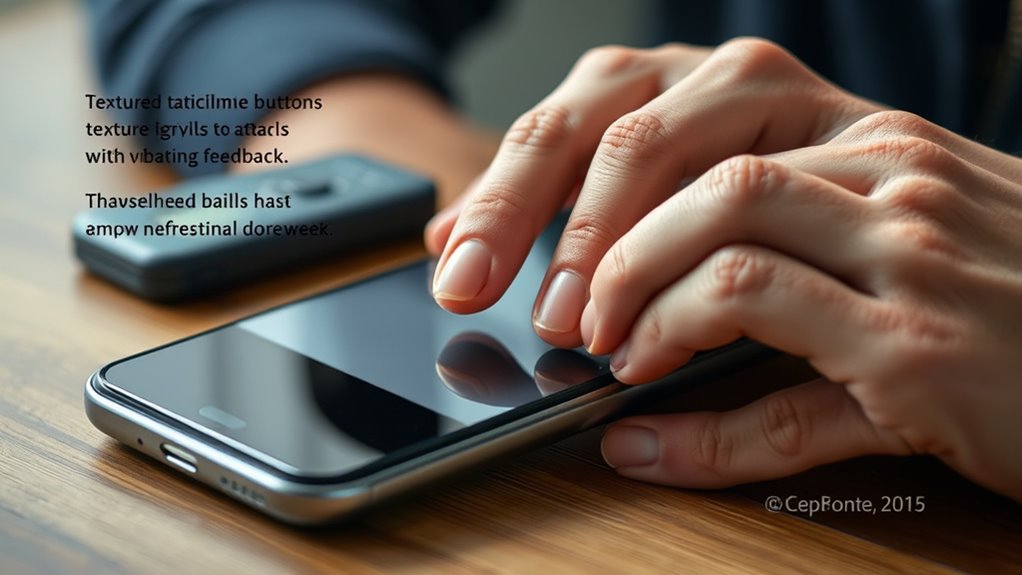
Assistive technologies like tactile communication devices and screen reading innovations are revolutionizing access for DeafBlind individuals. These tools enable you to connect with digital content more independently and effectively. By embracing these advancements, you can experience greater inclusion and communication opportunities. Additionally, best dog & pets resources can provide support and guidance for managing your overall well-being and daily activities. Staying informed about assistive technology options can further enhance your digital experience and independence, especially as automation continues to evolve and improve accessibility solutions. Understanding the importance of adaptive devices can help you make informed choices to maximize your digital interactions.
Tactile Communication Devices
How are tactile communication devices revolutionizing accessibility for individuals with combined hearing and vision loss? These devices use haptic feedback and tactile interfaces to deliver information through touch, bypassing traditional audio or visual channels. They enable you to feel alerts, messages, or navigation cues directly on your skin or fingertips. Incorporating dog names into the design of some devices helps personalize and enhance user engagement.
Screen Reading Innovations
Tactile communication devices have opened new pathways for conveying information through touch, but advancements in screen reading technologies are now further expanding accessibility. Modern screen readers utilize haptic feedback to alert you to on-screen elements, providing tactile cues for navigation. Gesture recognition has also improved, allowing you to interact with devices through specific gestures that trigger commands or read content aloud. These innovations make it easier to access apps, websites, and messages without relying solely on visual or auditory cues. By combining precise haptic signals with intuitive gesture controls, these screen reading tools enable you to explore digital content more independently and confidently. As technology continues to evolve, it offers even richer, more seamless ways for you to stay connected and informed.
Tactile Devices and Braille Displays: Bridging the Digital Gap

For deafblind individuals, tactile devices and Braille displays are essential tools that transform digital information into accessible formats. These devices enable you to read digital content through touch, bridging the gap between technology and sensory limitations. Tactile graphics allow you to feel diagrams, maps, and images, making visual information understandable. Braille keyboards give you a familiar way to input commands and messages directly on smartphones and computers. Many devices also incorporate dynamic Braille displays that update as you navigate online content. This technology empowers you to access emails, social media, and apps independently. Features like refreshable Braille lines and tactile overlays bring digital worlds within reach, fostering greater independence and engagement.
Tactile devices and Braille displays help deafblind individuals access digital content independently.
- Tactile graphics for visual information
- Braille keyboards for input
- Dynamic Braille displays for real-time updates
Voice-Activated Assistants and Their Role in Empowering DeafBlind Users

Voice-activated assistants have become powerful tools that substantially enhance independence for deafblind users by enabling hands-free control of digital devices. With simple voice commands, you can send messages, make calls, set reminders, or navigate apps without needing visual cues. These assistants are designed with accessibility integration, allowing seamless interaction through speech, even if you have limited or no sight. They interpret your commands accurately, reducing reliance on tactile or visual interfaces. This technology empowers you to perform daily tasks more efficiently and confidently. By integrating voice assistants into your smartphone or smart home devices, you gain greater autonomy and connectivity, making digital access more inclusive and user-friendly. Advances in AI security research help ensure these tools remain safe and reliable for users. Additionally, compatibility with various assistive technologies enhances their effectiveness for deafblind individuals. Incorporating Yoga techniques can also improve focus and mental clarity, further supporting your use of assistive devices. Ultimately, voice-activated assistants help break down barriers and foster greater independence in your digital life. Accessible technology plays a crucial role in ensuring that these tools meet the diverse needs of deafblind users.
Mobile Applications Designed for Enhanced Accessibility

Mobile applications specifically designed for enhanced accessibility play a crucial role in empowering deafblind users to navigate digital environments with greater ease. These apps incorporate features like haptic feedback, which alerts you through tactile signals, and extensive user customization options, allowing you to tailor the interface to your needs. With these tools, you can:
- Adjust vibration patterns for specific notifications
- Customize screen layouts and color contrasts
- Enable tactile cues for different functions
These features ensure a more intuitive experience, making it easier to access information and communicate effectively. By prioritizing tactile and personalized interactions, accessible apps help bridge the gap between technology and your unique sensory needs, fostering greater independence in everyday digital tasks.
Real-Life Success Stories of Digital Inclusion
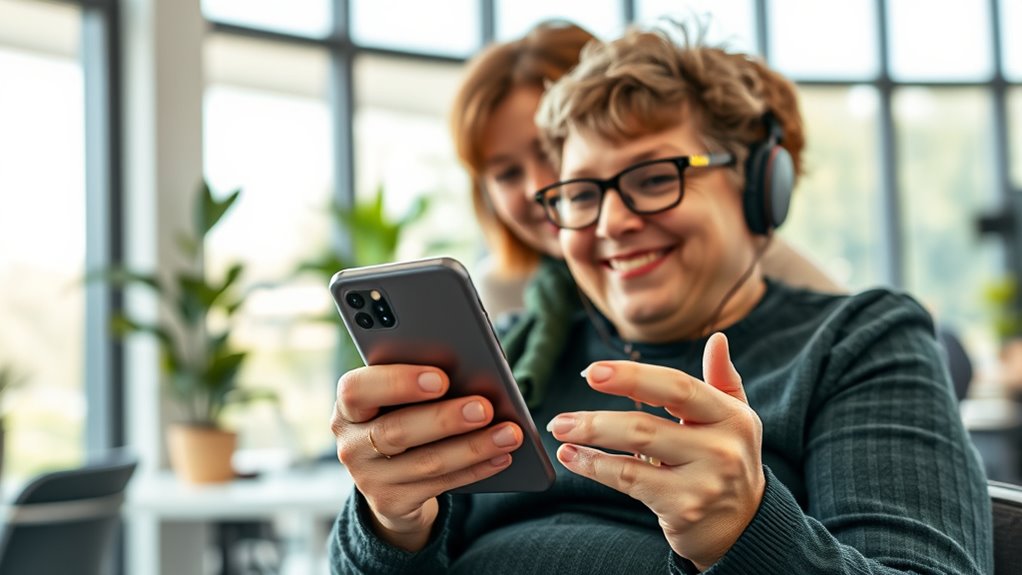
Many deafblind individuals have experienced life-changing moments thanks to accessible tech innovations. These personal triumphs showcase how digital tools can overcome barriers and open new opportunities. By exploring their stories, you’ll see the true impact of digital inclusion in action. Wall organization systems and aesthetic solutions, for example, are increasingly integrated into accessible home environments, further enhancing independence and comfort for users. Additionally, assistive technology plays a crucial role in bridging communication gaps and facilitating daily activities.
Accessible Tech Innovations
How are innovative technologies transforming digital access for DeafBlind individuals? They’re creating more inclusive experiences through multisensory feedback and adaptive interfaces. These advancements enable you to navigate devices with greater ease and independence. For example, tactile displays provide physical cues that complement audio and visual information, making content more accessible. Tactile feedback enhances user interaction by providing additional sensory confirmation, further breaking barriers and fostering digital inclusion. Adaptive interfaces adjust in real-time to your preferences, simplifying complex tasks. You might use haptic feedback to confirm selections or receive vibrations for notifications. Voice recognition combined with tactile controls allows seamless interaction without relying solely on sight or hearing. Incorporating vibrational feedback enhances user interaction by providing additional sensory confirmation, further breaking barriers and fostering digital inclusion, empowering you to connect, communicate, and access online services confidently and comfortably. Additionally, multisensory feedback systems are being integrated into mainstream devices to support diverse needs, making technology more universally accessible. Moreover, ongoing research and development efforts are continuously expanding the range of features designed specifically for sensory diversities, ensuring more inclusive digital experiences as technology advances.
Personal Triumphs in Access
Innovative technologies are transforming lives by turning accessibility features into personal triumphs. You’ve seen how some DeafBlind individuals develop emotional resilience, overcoming daily challenges through perseverance and adaptive tools. For example, many find empowerment in using tactile communication devices, which allow real-time interaction with loved ones and the broader community. Community support plays a pivotal role, providing encouragement, shared knowledge, and advocacy, boosting confidence and independence. These success stories highlight that technology alone isn’t enough; emotional strength and a supportive network are essential for meaningful inclusion. Additionally, portable assistive devices are becoming more accessible and easier to use, further enhancing independence. The increased availability of accessible technology demonstrates how innovation can directly impact individual lives positively. Your journey of digital access isn’t just about devices—it’s about building resilience, connecting deeply with others, and celebrating personal victories. These stories inspire others to pursue their own paths toward full digital participation, emphasizing the importance of digital inclusion in transforming lives.
Ongoing Initiatives and Future Directions for Inclusive Technology
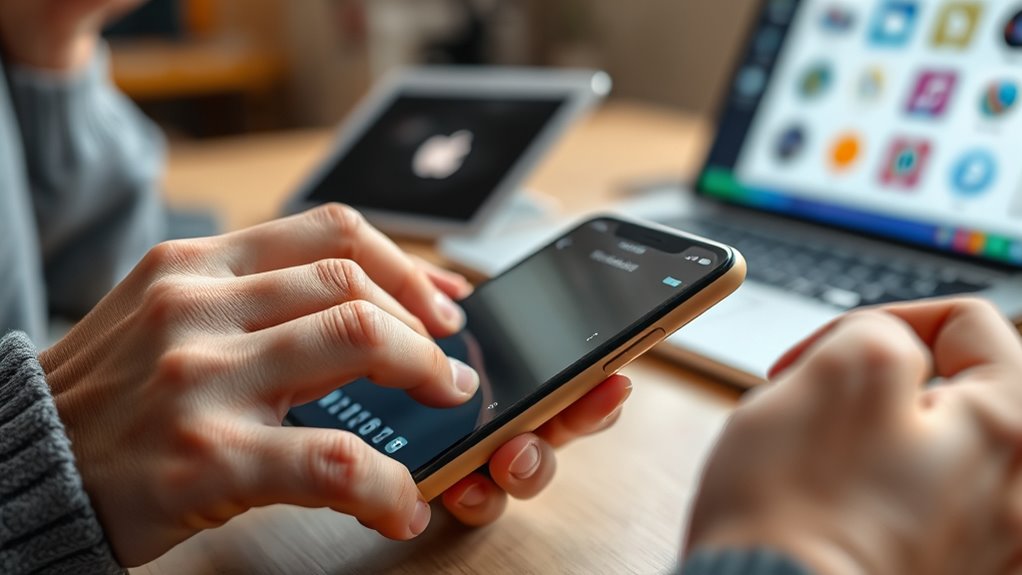
Recent initiatives in inclusive technology are actively expanding access for DeafBlind individuals, driven by advances in hardware and software solutions. These efforts emphasize community engagement and policy development to shape more accessible digital environments. Ongoing projects include:
Innovative tech developments are expanding access for DeafBlind users through community-driven solutions and policy advocacy.
- Developing tactile and haptic feedback systems to improve device interaction
- Incorporating AI-driven sign language recognition to bridge communication gaps
- Advocating for policies that mandate accessible features in tech products
These initiatives guarantee user voices influence future designs, fostering innovation rooted in real needs. By prioritizing community involvement, developers can create more effective solutions that empower DeafBlind users. Looking ahead, collaboration between industry leaders, policymakers, and advocacy groups will be vital. Together, these efforts aim to make digital spaces truly inclusive, enabling DeafBlind individuals to fully access and participate in online services. Additionally, leveraging Private Placement Memorandum insights can guide strategic investments in inclusive technologies to ensure sustainable development and widespread adoption. Furthermore, incorporating assistive technology innovations can significantly enhance user experiences and accessibility outcomes. For example, integrating accessible hardware tailored to DeafBlind users can further improve interaction and independence.
Frequently Asked Questions
How Affordable Are Advanced Assistive Technologies for Most Deafblind Users?
Advanced assistive technologies can be costly, but you should weigh the cost versus benefit carefully. While some devices may seem expensive initially, their technological affordability often improves over time, making them more accessible. You might find that investing in high-quality tools enhances independence and communication. Look for grants, subsidies, or community programs that help offset costs, making these essential technologies more within your reach.
What Training Is Available to Help Deafblind Individuals Navigate New Digital Tools?
You can access various training programs to help you navigate digital tools. Braille training improves your reading skills, while tactile workshops teach you to feel and understand device interfaces. Many organizations offer these resources, often tailored to your needs. You might also find online tutorials and community classes helpful. With the right training, you’ll gain confidence and independence in using smartphones and online services effectively.
How Do Privacy Concerns Impact Deafblind Users When Accessing Online Services?
Imagine your data privacy hanging in the balance every time you access online services. Deafblind users face unique challenges, needing clear user consent to protect their personal info. These privacy concerns can cause hesitation, making you wonder if your data is truly safe. You must stay vigilant, ensuring your rights are respected, so your digital experience remains secure and empowering rather than risky or intrusive.
Are There International Standards Guiding Digital Accessibility for Deafblind People?
You might wonder if international standards guide digital accessibility for deafblind users. Yes, there are accessibility guidelines like the Web Content Accessibility Guidelines (WCAG) which set international standards. These standards aim to guarantee digital content is usable by everyone, including deafblind individuals. While these guidelines help shape policies worldwide, implementation varies by country, so check local regulations for specific requirements.
How Can Developers Better Involve Deafblind Users in Designing New Technologies?
Did you know that involving users in development can improve accessibility? To better include deafblind users, you should prioritize inclusive design from the start. Engage them early through user feedback, ensuring their needs shape the technology. Collaborate with deafblind individuals, listen carefully, and test prototypes with real users. This approach creates more effective, accessible solutions that truly serve their unique communication needs.
Conclusion
As you explore the world of digital accessibility, you’ll find that innovative tools and dedicated efforts are gently opening doors for deafblind individuals. With continued advancements and compassionate design, the digital domain becomes a more welcoming space for everyone. Your awareness and support can help brighten the path toward true inclusivity, ensuring no one’s connection to technology remains out of reach. Together, you can help turn challenges into opportunities for all.

